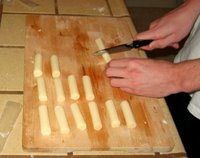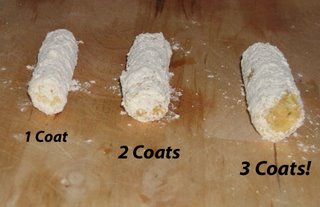Episode 4: Beignets & Café Au Lait
With the one-year anniversary of Hurricane Katrina recently behind us, we thought we'd do our part to aknowlege the hardships of the New Orleans community, and celebrate their past, present and future accomplishments, musical and otherwise. We came across something called a "beignet," which is traditionally served at breakfast with a café au lait.
A beignet is a simple, deep fried pastry whose recipe has remained unaltered since its introduction to New Orleans in the 18th century. And you thought Will Ferrel was was old school. Although smothered in powered sugar, a beignet doughnut is far less sweet than its other American cousins.
When we learned that beignets are typically enjoyed alongside a café au lait, we were in danger of breaking our longstanding "only one silent 't' on each menu" rule. However, since we were honoring New Orleans and its rich French-inspired heritage, we decided to make an exception. We were further reassured when we found out "au lait" translates to "with milk," a combination familiar to us. With that, let's get on with it!
| Part I: Man VS. Yeast | Soundtrack: Dr. John - Desitively Bonnaroo |
Although the prospect of having cells multiplying in our food was a little unnerving, we started by dissolving yeast in warm water. We made sure the water remained at a temperature that would keep our creature-friends alive and happy until fry time.
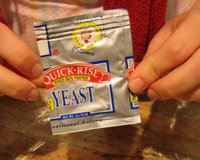 |  |
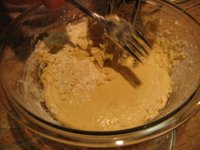 | 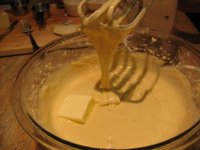 |
 live active cultures. In an epic battle of beast vs. machine, the yeast crept up and paralyzed the machine's wands of destruction. Will was forced to step into this seemingly hopeless situation and engage the yeast in a epic battle of man vs. beast.
live active cultures. In an epic battle of beast vs. machine, the yeast crept up and paralyzed the machine's wands of destruction. Will was forced to step into this seemingly hopeless situation and engage the yeast in a epic battle of man vs. beast.Armed only with a primitive wooden club and the po
 wer of the human spirit (not to mention his bulging biceps), he was able to slay the yeast beast and end the senseless warfare.
wer of the human spirit (not to mention his bulging biceps), he was able to slay the yeast beast and end the senseless warfare.With that, we laid the beast to rest in its Pyrex bowl, decorated with a brown paper fleur-de-lis to chill overnight.

| Part I: Morning After | Soundtrack: Dirty Dozen Brass Band - What's Goin On Elvis Costello and Allen Toussaint - River In Reverse |
It was the morning after. Thanks to the yeast, the dough rose overnig
 ht and was ready to be flattened. After applying a thin mist of flour upon the cutting board and rolling pin, Allison laid down the ball of dough and began to roll. She wielded a fiery rolling pin for upwards of 7 minutes before the dough was consistently flat.
ht and was ready to be flattened. After applying a thin mist of flour upon the cutting board and rolling pin, Allison laid down the ball of dough and began to roll. She wielded a fiery rolling pin for upwards of 7 minutes before the dough was consistently flat.It was then time to cut the dough into the traditional 2.5" squares. To accomplish this, we resorted a technique made popular in the early 18th century. Using an old-world instrument known as a "pizzá slicër," we cut the dough into squares.
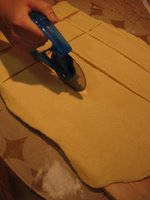 |  |
 little pastries were hot and fluffy.gingerly laid 5 squares at a time into the oil, to keep the temperature constant. After about two minutes of perpetual motion in the fryer, these cute little pastries were hot and fluffy.
little pastries were hot and fluffy.gingerly laid 5 squares at a time into the oil, to keep the temperature constant. After about two minutes of perpetual motion in the fryer, these cute little pastries were hot and fluffy.When each piece of dough had become a perfect, luscious pillow, we sprinkled confectioner's sugar over the top.
 The beignets were begging to be our indulgence, and we obliged.
The beignets were begging to be our indulgence, and we obliged. |  |



